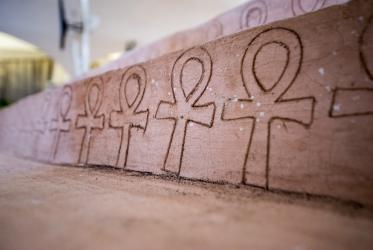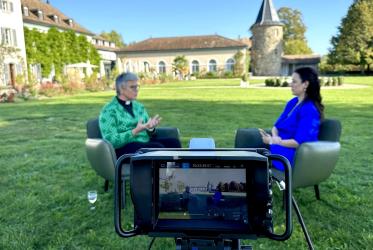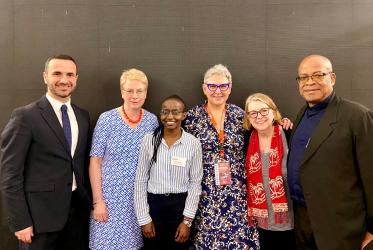By Odair Pedroso Mateus*
This text is dedicated to Rev. Dr Ofelia Ortega, with much gratitude.
Who on earth decided in June 1920 in a conference held in Crans, near Geneva, that the following year at Lake Mohonk, New York, an International Missionary Council would be established and give an enormous institutional impulse to the emerging ecumenical movement?
I can tell you who attended the conference in Crans, which missionary organisations were represented, but I cannot tell you precisely under whose mandate they were there and took such an epoch-making decision. Like many other ecumenical stories, this one starts with the Edinburgh missionary conference in 1910. I promised I would not call it “When Mott meets Oldham.”
Seen in hindsight, what were some of the achievements of Edinburgh 1910? I will mention a few and let you add others, especially if you have followed, around the centennial of the conference in 2010, the study process and the library it gave rise to under the leadership of distinguished missiologists such as Kenneth Ross, Kirsteen Kim, and Brian Stanley - the author of one of the most recent accounts of the conference.
Edinburgh 1910 was the moment when representatives of missionary societies and churches gathered in the same place realised in a deeply spiritual way that they shared a great measure of oneness in Christ and that by fulfilling together their common calling they would be more faithful to their mission. Those present in Edinburgh knew, in the words of William Hogg, “that from within their midst something different was emerging. It was a desire for an inclusive togetherness unknown before.”
Task of the whole church
The first words of the constitution of the World Council of Churches would later reflect this experience and awareness of the mutual imperatives of mission and unity. “The World Council of Churches is a fellowship of churches that confess the Lord Jesus Christ as God and Saviour according to scriptures and therefore seek to fulfil together their common calling for the glory of the one God, Father, Son and Holy Spirit.” Along similar missional lines, the 1951 WCC Central Committee would describe the meaning of the term “ecumenical” as “everything that relates to the whole task of the whole church to bring the gospel to the whole world.”
Edinburgh 1910 was dedicated primarily to the analysis of and consultation about international missionary work rather than to inform, recruit or mobilise support for it. John Mott (1865-1955), its main chairman, had envisioned it as a “thorough consultation and study” on “the most vital questions of missionary opportunity and policy.”
This required careful and sustained preparation. Mott’s alter ego, Joseph Oldham (1874-1969) was the secretary of a committee which chose the eight subjects of the conference and supervised the production by different commissions of resources for the conference discussions. Future ecumenical gatherings such as the Oxford 1937 Conference on Life and Work and the Amsterdam 1948 foundational assembly of the World Council of Churches would follow the Oldham school of excellence in conference preparation.
Unlike previous similar international gatherings, Edinburgh was a conference of official representatives from societies whose missionaries were serving abroad, but only in non-Christian lands. This criterion, together with the exclusion from the agenda of discussions on controversial matters of faith and church order, opened the door to the participation of German Protestants, who regretted free churches mission in their country; and British Anglo-Catholics, who were not keen on joining a conference attended by American Presbyterians or southern Baptists engaged in mission among Roman Catholics in Brazil and elsewhere in Latin America.
Laboratory of leadership
Edinburgh intended to be an inclusive conference. True, out of its 1215 delegates, only 19 came from missionary lands: 18 from Asia and one from Africa. But they exerted an influence “out of all proportion to their numbers.” William Hogg noted that “From an Indian, V. S. Azariah, and a Chinese, Cheng Ching-yi, came Edinburgh’s two best remembered speeches.” The conference was also the laboratory of a new leadership issued from youth inter-denominational movements. That was the case of Mott and Oldham, but also of the future archbishop of York William Temple, who was a steward at the conference.
Immediately after the conference, its Continuation Committee met under the leadership of the tandem Mott & Oldham. Nine working groups were appointed to harvest the conference’s fruits and project them into the future. Their method, which involved ample consultation to hundreds of people around the world on different issues, would later inspire what has been known in WCC assemblies as “ecumenical conversations.”
One of the conference fruits would ripen one year later and remain with us: the International Review of Missions (IRM), first published in January 1912. I presume that the encounter between the notion of missio Dei and positive theological views on secularisation was fatal to the last “s” of its title around 1970. The IRM pioneered world mission survey and opened its pages to Roman Catholic contributions. Oldham was the IRM editor, but soon its driving force would be the missionary, educator and editor Georgina Gollock.
In an article on the legacy of Oldham for the International Bulletin of Missionary Research, Kathleen Bliss referred to Gollock as “one of unsung heroes of the ecumenical movement.” There is no “Gollock, Georgina Ann” entry in the Dictionary of the Ecumenical Movement. Born in Ireland in 1861, Gollock was 29 when she joined in London the editorial department of the Anglican-Protestant Church Missionary Society, where she was the first woman to hold an executive position. Oldham began to appeal to her editorial and management skills in the IRM as early as 1912. In 1921 she became IRM’s associate editor and one year later co-editor, holding that position until 1927. In the following years Gollock wrote, among others, several books about Africa, valuing the link between Christian experience and African traditions.
William Paton, “the indispensable diplomat and bureaucrat behind the creation of the WCC” and organiser of the missionary conferences of Jerusalem 1928 and Tambaram 1938, authored Gollock’s obituary in the IRM in 1941. He quoted his lifelong friend Oldham: Georgina “was one of the people who taught me by example that a Christian enterprise ought never to be content with anything short of the best.”
While Oldham and Gollock were building the International Review of Missions, Mott was giving impetus to another longstanding missionary contribution to the modern ecumenical movement. On suggestion of the Continuation Committee, he embarked in October 1912 on a seven-month tour of Asia, from today’s Sri-Lanka to Japan, including Myanmar, India and China. He held no less than eighteen conferences with the participation of missionaries and emerging national leaders. The main focus was the transfer to the nationals of the results of missionary work.
This led to the logic establishment in countries such as India, China, Japan of national or regional inter-denominational councils of missions and churches. The Swiss historian Philip Schaff had anticipated the emergence of conciliar ecumenism as early as 1893 in an address on “The Reunion of Christendom.” In 1947 Mott would see their establishment in different continents as his “greatest contribution” to the International Missionary Council.
The outbreak of the Great War in 1914, opposing Germany to Britain among other countries, had a devastating effect on international missionary cooperation and put an end to the work of Edinburgh’s Continuation Committee. German missionaries serving in British or French colonial lands came under suspicion of spying for the enemy. Most of them – and they were about 2000 around the world - had to leave their missionary and educational fields. Following the entering of the US in the war and Mott’s participation in an official US mission to Russia, noted Kenneth Latourette, “the Germans felt that he had betrayed them.” They rejected his leadership and pushed for his resignation.
Post-war healing
Towards the end of the war, the Ally countries intended to confiscate German missionary properties around the world. The international Continuation Committee, now inactive, was replaced in 1918 by an Anglo-American Emergency Committee. Edinburgh’s “oneness in Christ” had been shattered by mistrust. Nationalism once again had prevailed (it was not the last time) over the search for the visible manifestation of the church catholic.
June 22, 1920. The Château de Crans, within a walking distance of the (worldwide famous…) Château de Bossey, is the venue of a conference meant to pursue post-war healing and reconciliation and mark “a new beginning of international missionary cooperation.”
Surrounded by vineyards, built in a Louis XV style in the second half of the 18th century, the Château, to which Guillaume Fatio dedicated nine pages of his history of Céligny, is owned by the van Berchem family. The French-Swiss Pierre de Benoit, Paul van Berchem’s son-in-law, is an active supporter of the Basel Mission’s work in India. He has expressed to Mott and Oldham the willingness to host the meeting in what is today the village of Crans-près-Céligny. William Hogg wrote about the van Berchem family that “for months they had held family prayers” that the conference “might bring increased international missionary understanding and effectiveness.”
The group picture suggests a meeting of about 35 people. They represent no less than ten missionary organisations from ten western and northern European countries plus the US and white South Africa. Among them, for the first time since the war, four German members of the Edinburgh Continuation Committee. A slow and painful process of reconciliation is underway.
Once again Mott is the chairman and Oldham the secretary. The agenda includes two main topics. The first, “Mission and Governments,” focus mainly on the post-war situation of German missions. Thanks to Oldham’s diplomatic efforts, the confiscation of German missionary properties has been removed from the 1919 Treaty of Versailles. The Crans meeting issues a statement calling for the return of the German missionaries to their stations.
The second theme is the future organisation of international missionary cooperation. In preparation for the meeting, Oldham has written the booklet The Missionary Situation after the War. Referring to the creation of the League of Nations, he notes that “the questions to which attention has directed in this and preceding sections seem to point to the necessity of some form of international missionary organisation.”
Oldham takes a step further in a memorandum outlining possible institutional scenarios. He proposes the establishment of an international missionary agency in charge of coordinating the work of national missionary councils. At the same time, he realises that “…it is becoming less and less possible to discuss missionary matters without representatives of the churches in the mission field.” His vision then takes him beyond the future International Missionary Council. Any organisation that may be created, he concludes, “will probably have before long to give way to something that may represent the beginning of a world league of churches.”
The Crans meeting ended exactly a century ago, June 28, 1920. Established one year later, the International Missionary Council (IMC) will be “the first organisational embodiment of the ecumenical spirit in the Churches themselves,” and it will remain so until the first assembly of the World Council of Churches in 1948. But if you don’t mind, I must add for the record that Mott was elected the IMC chairman and Oldham its secretary.
In one of his last writings, published in a book edited by William Temple towards the end of World War II, Oldham’s successor in the IMC William Paton noted that “it is impossible for any Christian mind to doubt that the drawing together on the part of the churches just at the time when political hopes of peace grew darkest was no less than the act of God training and fitting us for what was to come.”
In times such as ours in which global problems are met by growing hostility to international cooperation, the ecumenical movement appears once again as a counter-cultural expression of the proclamation of God’s new creation in the compassionate love manifested in Christ.
* Odair Pedroso Mateus is director of the Faith and Order Commission of the World Council of Churches (WCC) and interim Deputy General Secretary for Unity and Mission.
Read also:
1920 (1) - A beautiful letter from the Church of Constantinople
1920 (2) - “God wills fellowship”: The Anglican Bishops’ Appeal to Unity







